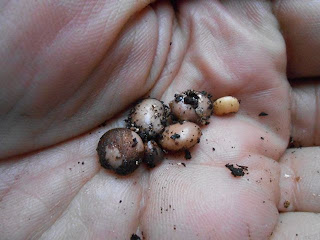Yabumame (Amphicarpaea edgeworthii) is the Asian version of talet (Amphicarpaea bracteata), one of my favourite underutilised legume crops, whose many virtues I've mentioned on several occasions previously. If you're looking for a cunning botanical strategist, which is also tasty to boot, look no further than Amphicarpaea.
Yabumame's status as a separate species seems to be under question and it appears that we should all be calling it Amphicarpaea bracteata subsp edgeworthii. It does look very similar to A. bracteata proper.
I've already grown yabumame, but that variety came from seeds I collected myself around Tsukuba, Japan. They did OK, but I couldn't help feeling that plants from further north would be more suitable. Luckily, Paolo Gaiardelli came to my rescue when he brought back seeds from Hokkaido and graciously passed some of them on to me.
As with hopniss, sourcing northern provenance seeds makes a lot of sense for those of us foolhardy enough to live at high latitudes. Plants are somewhat more likely to tolerate our temperature regime and get on with the business of flowering or tuberising during our long day summers. So runs the theory, anyway. Hokkaido summers are cooler than the rest of Japan and the winters are snowy and cold. Cooler is of course, a relative term, but as yabumame grows in woodland habitats in its native range and talet has done well here, it seemed safe to assume that it would also thrive.
I sowed some seeds in the spring; they germinated and grew, although not enthusiastically, it has to be said, with foliage and habit of growth more or less a dead ringer for talet. When the puny amount of top growth died back in August, with nary an aerial pod in sight, I was disappointed. Perhaps the growing medium lacked the necessary rhizobium, or they got too hot, cold, dry or wet at some stage and never recovered. I cursed my horticultural ineptitude yet again and resigned myself to sowing some of the remaining seeds next spring.
Before recycling the compost, I tipped it out into my hand and was surprised to discover some rather small, but reassuringly plump, subterranean seeds. If a sickly slip of a plant can deliver the goods, imagine what a fine, strapping individual might have achieved. Assuming these seeds survive the winter, they should grow away well next spring. Underground seeds tend to give much bigger plants, with higher yields in my experience, so perhaps everything is unfolding as the universe intended.
Having spent several years amassing Amphicarpaea varieties, it must now be time to start doing some comparative trials, with a view to breeding a super talet. In my mind's eye I can see it now, with its neat, bushy habit and handfuls of tasty beans easily accessible just below the soil at the base of the plant. While I work towards this goal, I know that eating those which fail to make the grade will be no hardship: Amphicarpaea is one of the best wild foods out there.
Yabumame's status as a separate species seems to be under question and it appears that we should all be calling it Amphicarpaea bracteata subsp edgeworthii. It does look very similar to A. bracteata proper.
I've already grown yabumame, but that variety came from seeds I collected myself around Tsukuba, Japan. They did OK, but I couldn't help feeling that plants from further north would be more suitable. Luckily, Paolo Gaiardelli came to my rescue when he brought back seeds from Hokkaido and graciously passed some of them on to me.
As with hopniss, sourcing northern provenance seeds makes a lot of sense for those of us foolhardy enough to live at high latitudes. Plants are somewhat more likely to tolerate our temperature regime and get on with the business of flowering or tuberising during our long day summers. So runs the theory, anyway. Hokkaido summers are cooler than the rest of Japan and the winters are snowy and cold. Cooler is of course, a relative term, but as yabumame grows in woodland habitats in its native range and talet has done well here, it seemed safe to assume that it would also thrive.
 |
| The glorious top growth of yabumame |
 |
| Yabumame beans: small but full of eastern promise |
Having spent several years amassing Amphicarpaea varieties, it must now be time to start doing some comparative trials, with a view to breeding a super talet. In my mind's eye I can see it now, with its neat, bushy habit and handfuls of tasty beans easily accessible just below the soil at the base of the plant. While I work towards this goal, I know that eating those which fail to make the grade will be no hardship: Amphicarpaea is one of the best wild foods out there.
Comments
I'm glad your Amphicarpea are growing well this year.